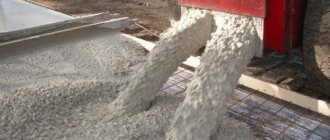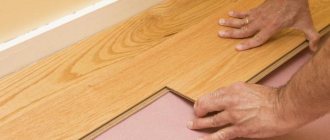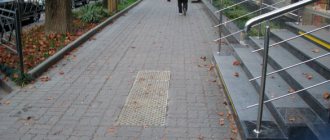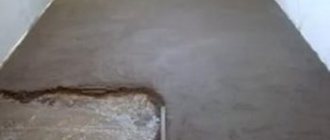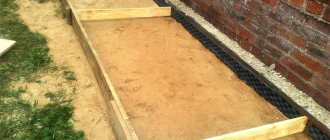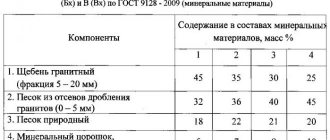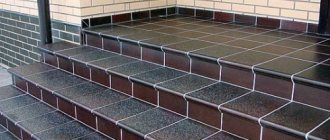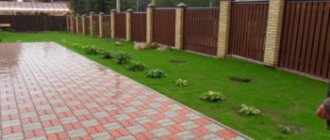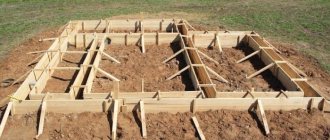Methods for laying concrete mixture in formwork
The quality of concrete in a structure largely depends on the correct placement of the concrete mixture during concreting. The mixture must adhere tightly to the formwork, reinforcement and embedded parts of the structure and completely (without any voids) fill the volume of the concreted part of the structure.
Typically, the laying process is divided into two operations: leveling the concrete mixture supplied to the structure and compacting it at the laying site.
The most common concreting scheme involves laying horizontal layers over the entire area of the concreted part of the structure.
| Concreting with horizontal layers (a) and steps (b) |
| 1 - laid concrete, 2 - new layer of concrete mixture; N - no more than 1.5 m |
All layers are laid in the same direction and of the same thickness. The layer is concreted continuously.
The complexity of the leveling operation depends on the method of supplying the concrete mixture to the block, its mobility or rigidity and the thickness of the layers being laid.
If the concrete mixture can be supplied to any area of the structure being concreted, then the labor intensity of the leveling operation is reduced to a minimum; if not, then the concrete mixture has to be moved horizontally. When laying the mixture, throwing it over to avoid delamination is allowed only in exceptional cases; double transfer is not allowed at all.
The shape of the cone formed after unloading it from vehicles depends on the mobility and rigidity of the concrete mixture. A rigid concrete mixture forms a cone with steep slopes, while a flexible concrete mixture forms a cone with gentle slopes. The concrete mixture, which forms a cone with a gentle slope, is easier to distribute in the layer. The greater the thickness of the laid layers of concrete mixture, the less the amount of leveling work. The mixtures in the block are leveled using a small-sized bulldozer or manually with shovels.
Each laid layer is thoroughly compacted before laying the next one. The less fluid the mixture is, the more labor is required to compact it.
The duration of laying the layer is limited by the time when the cement begins to set. Overlapping the previous layer with the next one must be done before the cement in the previous layer begins to set. The time for laying and overlapping layers is determined by the laboratory. It depends on the outside temperature, weather conditions and the properties of the cement used, approximately it is equal to 2 hours.
If the laying time of the layer exceeded the period established by the laboratory, then when vibrating the subsequent layer, the solidity of the concrete of the previous one will be disrupted, so concreting should be stopped.
Resumption of concreting is allowed only when the concrete reaches a compressive strength of at least 15 kg/cm2. The moment when concrete reaches such strength is determined by the laboratory.
At the point of contact between previously laid concrete and freshly laid concrete, a so-called working joint is formed. To ensure good adhesion of previously laid concrete to freshly laid concrete, the surface of previously laid concrete is left uneven (not smoothed) and processed according to the rules set out in the section Installing formwork.
Immediately before concreting, the surfaces of hardened concrete are covered with a 2-5 cm thick cement mortar or a layer of plastic concrete mixture. The strength of the hardened mortar or concrete in the contact layers must be no lower than the strength of the concrete structures. In especially critical cases, colloidal cement adhesive with a water-cement ratio of up to 0.35 is used, applied with a thickness of no more than 5 mm to hardened concrete in the working seam before continuing concreting.
In large areas, it is sometimes impossible to cover the previous layer of concrete before the cement begins to set. In this regard, on some construction sites the concrete mixture is laid in steps (Fig. 98, b) with the simultaneous laying of 2-3 layers. When concreting in steps, there is no need to cover the layers over the entire area of the massif. In this case, a rigid concrete mixture is used and only the steps are covered.
Laying in steps is permitted provided that the detailed concreting technology is followed. This method is used when concreting hydraulic structures with long blocks with a length-to-width ratio of more than 2. In domestic construction, there are examples of concreting with blocks 70 m long and 15 m wide.
When concreting structures, it is necessary to ensure that the position of the formwork, reinforcement and embedded parts remains unchanged. While the concrete mixture has not hardened, some displacements from the design position can be easily eliminated.
During concreting, it is necessary to systematically clean the reinforcement, formwork and embedded parts from adhering mortar, and also protect the concrete structure from rain. Concrete washed away by rain must be removed from the structure.
It is advisable to erect monolithic concrete and reinforced concrete structures without seams. But during the construction of large structures, it is completely impossible to fulfill this requirement, since cracks would form in monolithic structures under the influence of temperature fluctuations and uneven settlement. Therefore, large concrete and reinforced concrete structures are divided into sections using expansion joints.
Seams that divide a structure into sections to prevent the appearance of cracks in concrete from thermal stress are called temperature joints. Seams that prevent cracks from appearing in concrete due to uneven settlement of the structure are called sedimentary. If the structure must have both temperature and sedimentation joints, they are usually combined. Such expansion joints are called temperature-sedimentary joints.
Expansion joints are filled with gaskets against blowing or covered with bitumen dowels (sealing barrier) for watertightness (in hydraulic structures).
The structure or its sections between expansion joints are temporarily divided by additional joints into smaller parts that are concreted without interruption, called blocks or concreting sections. Breaking down into blocks is required both to reduce shrinkage and temperature deformations of concrete associated with heat generation during setting and hardening of cement, and because of the limitation of the area of the concreted area, necessary for the possibility of timely overlap of layers during concreting. Such seams are called construction and shrinkage seams.
Since most structures have to be concreted intermittently (for example, to install formwork and reinforcement), work joints are formed in places where concreting is interrupted. They are usually combined with construction and shrinkage joints. Therefore, the distance between construction joints is set taking into account the conditions of work on the basis of technical and economic calculations.
In order to speed up and reduce the cost of construction, it is advisable to take the block sizes in plan as large as possible, and therefore, the distance between construction and working seams can be as large as possible, since this reduces the volume of formwork and preparatory work on the structure.
- Concrete science
- Manufacturing technology of prefabricated reinforced concrete structures and parts
- General issues in precast concrete production
- Preparation of concrete mixtures
- Production of mortar mixtures
- Transporting concrete mixture
- Preparation of reinforcement
- Formwork Classification of formwork
- Installation of formwork
- Preparatory work
- Methods for laying concrete mixture in formwork
- Preparing molds, forming concrete and curing products
- Reinforcement and forming of prestressed products
- Features of the production of various types of concrete and reinforced concrete products
- Concreting of various structures
- Concrete work in winter conditions
- Production of prefabricated structures and parts from lightweight concrete
- Production of prefabricated products from dense silicate concrete and concrete with clinker-free binder
- Production of concrete and reinforced concrete products at landfills
- General safety rules and fire prevention measures at a construction site
Concrete laying technology
Concrete is a man-made stone material used in construction and is obtained by hardening a mixture usually consisting of cement, sand and water. Sometimes special additives are placed in it, in accordance with the requirements and climatic conditions, and sometimes it is made without water, such as asphalt concrete. A variety of methods help achieve high-quality concreting in a variety of areas: both very hot and cold.
For large volumes of work, they are usually prepared at specialized enterprises.
For preparation, you must accurately select the ratio of components and possible additives.
The composition of the mixture is determined in accordance with the requirements for the final object. For example, you need to know what the compressive strength should be, what the expected volumetric mass is, and, of course, how the installation will be done. The installation technology depends on many factors, but it is thanks to the various options and choices that you can always achieve the desired result.
Features of the work
Installation consists of several steps:
Thorough mixing is ensured by a concrete mixer; when pouring large areas, its use is justified.
- Delivery to the place of work.
- Unloading.
- Distribution.
- Alignment.
- Seal.
Laying and work associated with it are very labor-intensive and energy-intensive. In large industries, all work is carried out using special machines, such as concrete pavers or concrete distributors. But at the same time, of course, workers are also needed to monitor the process.
Concrete must be placed in forms so that there are no free spaces or internal voids left. Particular attention should be paid to corners and bottlenecks, if any.
Before you begin laying the mixture, you need to carefully check the readiness of the formwork and, in addition, decide on some points without which you cannot begin laying.
Technical parameters that need to be clarified before installation:
- consistency and mobility of the mixture, its composition;
- what method will the mixture be supplied to the work site;
- how the solution will be distributed and compacted;
- what will be the thickness and sequence of the layers being laid;
- mixture flow rate;
- number of workers and necessary mechanisms;
- Is the required amount of the mixture ready?
Surface cleaning and preparation
Before starting installation, be sure to clean the area where the concrete will be poured. Debris, dirt, possibly snow or ice and anything that may interfere with installation must be removed.
When pouring large areas, it is convenient to use a concrete pump.
- If there are oil residues on the surface, the surface must be washed using special cleaning agents.
- It is not allowed to leave water on the surface.
When laying the mixture on the surface, it must also be prepared and carefully cleaned of the cement film.
To do this, you should not use jackhammers, concrete breakers, and so on. Such cleaning can weaken the underlying layers of concrete, which means that the contact between layers, the overall strength and reliability of the structure will likely deteriorate. To avoid dehydration, the surface should be well moistened, but remove any remaining water before pouring.
In this case, the mixture or concrete laid on the contact surface cannot be of poor quality. The fittings need to be prepared by cleaning them of dirt.
Mixture supply
The following delivery methods are convenient for concreting foundations:
- unloading directly from the mixer tray directly into the formwork, provided that there is spatial opportunity for the mixer to approach the work site, at a distance of the length of the tray;
This will greatly facilitate and speed up the work process. The best time to think about this, of course, is at the construction planning stage. If access is not possible, then another method should be used.
If pouring occurs in a place where installation of a concrete pump or vehicle access cannot be carried out, then I install a gutter.
- If it is impossible for the mixer to reach the work site, it is necessary to ensure supply through a chute. The gutter is made from any available material, most often from ordinary boards.
In this case, additional workers will definitely be needed. One person with a shovel is required per m of tray to push the mixture down the chute.
It should also be taken into account that the lower the mobility of the concrete or mixture, the more difficult the process will be, even if the gutter is inclined towards the formwork.
For concreting walls, columns and monolithic slabs:
- A concrete pump is used when there are no alternatives. When ordering a concrete pump, please note that the concrete being prepared or purchased must have increased fluidity but, of course, maintain its brand.
- To use a bell, in other words, a bowl with a closing drain hole at the bottom, additional equipment is required, that is, a tap. It is the crane that lifts the bell filled with concrete, and then pours the concrete through the drain hole into the right place.
One of the common laying technologies is to install horizontal layers. Their thickness varies from 30 to 50 centimeters. The layers are laid in one direction. The thickness of one layer should not have differences.
It is recommended to carry out laying without stopping. Each new layer must be laid and then compacted before the previous layer sets.
But this is not the only way to fill. You can fill each block individually to its full height. If you do not have enough mixture when pouring layer by layer, then to continue work you need to wait until the poured layer has completely dried.
Distribution
To increase strength, it is advisable to pour the solution continuously.
- Distribution is not necessary if it can be supplied to any site. If this is not possible, then the concrete is moved horizontally using shovels or other mechanisms.
- Double transfer according to the technology is not allowed, as this threatens delamination. The thicker you pour the layers, the less work there is to spread.
The speed of distribution work is very high, since after it there is still other work to be done that needs to be done before setting begins.
Alignment
The presence of a reinforcement cage in the design simplifies the work; in this case, you do not need alignment.
If there is no frame, then beacons should be placed in advance. Typically, reinforcing bars are used for this.
Seal
Compaction is carried out using a vibrator, which you can buy or create yourself. In any case, this process is mandatory.
The frequency of the step depends on the density of the solution and your tool. With a correctly calculated step, holding the vibrator in one place for 5 to 15 seconds is enough.
Compaction in production is carried out not only by vibration, but also by vibration stamping, vacuuming, rolling and centrifugation.
- For laying open surfaces and large areas, not deep, but surface vibrators are used. During operation, they transmit vibrations through a metal pad attached to them.
Pouring the floor
The quality of the floor directly depends on the preparation process. Laying floors can be carried out either on a load-bearing slab or on a crushed stone-sand surface.
https://youtu.be/CdexTEDyBQY
In the second option, the surface must be leveled and compacted. When carrying out installation work on a load-bearing slab that has cracks, it is necessary to carry out preliminary repair work.
You can fill the cracks with the same solution that you will use to cover the floor. Concrete flooring has been popular for quite some time, as it has the ideal combination: reasonable price + excellent quality.
Beacons are placed to ensure that the floor is level.
Laying the floors begins after installing the waterproofing layer. Strength can also be improved by using reinforcement, which can be reinforcement, mesh or fiber.
In order to construct a floor with a hardened surface, the grade of concrete should not be lower than M300/B22.5 and in no case should it contain additives.
Self-leveling floors, both with and without a hardened surface, can be made in warehouses, living rooms, shops and on the street, for example, in a parking lot. The concrete floor can be both the final covering and the basis for the next layer.
To lay the floor you will need:
- roulette;
- knife;
- rule;
- Master OK;
- ruler-level;
- hydraulic level;
- putty knife;
- screwdriver and screws;
- profile, maybe PN27*28 or similar;
- drill or mixer with an attachment for kneading the mixture.
Stages of work
In order to achieve a perfectly flat floor, self-leveling mixtures are used after pouring the screed.
- Using a hydraulic level, mark around the entire perimeter of the room, making marks as often as possible. Then connect all the marks into one continuous line.
- The next step is to install the profile system. You need to fix them with a cement mixture or fasten them with self-tapping screws, adjusting the height of the profile and twisting the screw heads to the height you need.
- If you purchased the ready-made mixture at a hardware store, then you need to follow the instructions that came with it. When making concrete yourself, use a mixer or drill with a mixing attachment. The quality of the floor will depend on the quality of kneading.
- Having prepared the required volume of the mixture, pour the floor and, using the rule, achieve a perfectly flat surface.
If there are large differences in the surface and the need for insulation, the process of laying the floor is somewhat different.
Before laying the final top layer, you need to make a rough screed, the thickness of which depends on the size of the differences. To facilitate the installation of self-leveling floors, you can also use self-leveling mixtures.
Page 2
- Reinforcement
- Kinds
- Manufacturing
- Tools
- Installation
- Calculation
- Repair
1pobetonu.ru
Concrete laying: technology for creating reinforced concrete structures. Winter concreting
Laying concrete on the ground or on a sand cushion must be carried out using a method that will ensure the concrete structure is solid, the uniformity of the solution and high-quality adhesion to the reinforcement structure.
In addition, the technology must ensure the chemical and physical characteristics stated in the design documentation, as well as guarantee complete filling of the decked structure with the building mass.
Leveling the coating
Methods for laying mortar
The process of laying the building mixture can be done using one of the following methods:
- Casting;
- Laying with compaction;
- Pressure laying.
Regardless of which method was chosen, the concrete laying technology must be carried out in compliance with the basic rule of laying layers. This rule states that the next layer cannot be poured until the previous layer has dried.
Leveling with shovels
Note! Strict adherence to this condition eliminates the need for work on arranging joints between layers along the height of the concrete structure.
If we are talking about small structures such as columns, walls, beams, etc., then the mortar is laid without interruption. This method of creating concrete products eliminates the occurrence of working seams on the surface of the monolith.
If concrete slabs are laid under a fairly massive foundation, then the mortar is laid in horizontal layers over the entire surface of the structure.
In order to ensure the monolithic structure of the multilayer construction method, the following conditions must be met: h
- h is the thickness of the layer laid on the surface, in m;
- A – area of the monolithic structure, m2;
- Q – solution supply intensity, m3/h;
- t – maximum time allowed for laying a new layer on a previously laid concrete layer, in hours.
Note! On large construction sites it is not always possible to wait for the previous layer to set before laying the next one.
In such a situation, a stepwise pouring method is used, which involves simultaneous pouring of 2-3 layers of the mixture, each of which must be at least 3 mm thick.
Technology for creating reinforced concrete structures
The technology for laying concrete on a road or in the ground is determined by the following factors:
- Construction type;
- Requirements for the product being created;
- Composition of the mixture;
- Design features of the created formwork;
- Method of supplying the solution;
- Place of work.
Concrete masses and foundations for buildings can be laid using various methods, depending on parameters such as:
- Deepening;
- Volume of reinforced concrete structure;
- Product height;
- Type of concrete solution.
Concrete mixture can be unloaded directly from a vehicle from an overpass or moving bridge, using devices such as:
- Vibrating chute;
- Vibrating feeders;
- Concrete pumps;
- Concrete placing machines;
- Buckets with taps.
Advice. If it is necessary to create a lightly reinforced foundation, then concrete mixtures with sufficient rigidity should be used, which have a cone settlement of no more than 1-3 cm, and for densely reinforced ones - 5-6 cm.
Installation of concrete for flooring
Floor arrangement
In order to make concrete preparations for the construction of the floor, it is necessary to use a concrete solution whose cone settlement will be no more than 2 cm.
The work instructions in this case will consist of the following steps:
- The formwork, which is the basis for pouring, is divided into strips no more than 4 m wide. For such division, beacon boards are installed;
- The delimited strips are filled with construction mixture one at a time;
- After the laid mixture has hardened, pouring of the intermediate strips begins.
Now that everything is prepared for pouring the concrete floor, it is arranged as follows:
- The solution is unloaded directly from the concrete truck or it is supplied to the formwork using concrete pumps;
- The fill is roughly leveled using shovels;
- The monolith is compacted using a vibrating screed;
Working with a vibrating screed
Advice. The vibrating lath does not move from its position until it is lowered onto the beacon boards with both ends.
- After 20-30 minutes, after compaction has been completed, the surface is smoothed using hand tools or a trowel;
- After 30 minutes, the smoothing field is grouted using a metal float.
This treatment results in a high-quality concrete floor with acceptable strength and abrasion resistance.
Note! If it is planned to install concrete, cement, asphalt floors or lay foam concrete, then the surface after compacting the concrete with a vibrating screed is left rough to improve adhesion to the coatings.
If you want to increase the density and hygiene of such a floor, you should use the ironing method. To implement it, dry cement powder is rubbed into the surface of the freshly laid mortar using a trowel, a trowel or a steel float.
Features of arranging concrete partitions and walls
Permanent formwork
What technology will be used to fill the walls directly depends on the type of formwork used, as well as the thickness and height of the walls.
There are some features of the production of such work that anyone who decides to fill the walls with their own hands should definitely know:
- When using demountable formwork, pouring should be done in sections no more than 3 m high;
- When the wall thickness is more than 50 cm, the weak reinforcement method should be used and poured with a mixture with a cone draft of about 4-6 cm;
- If the length of the walls is more than 20 m, pouring should be done in sections of 7-10 m, using dividing formwork;
- The solution must be supplied to the formwork at several points simultaneously using a vibrating chute, bucket or concrete pump.
Advice. Feeding the raster to only one point will lead to looseness and inclination of the layers, which will reduce the uniformity and quality of the monolith.
The photo shows the process of pouring walls and partitions
If all these recommendations are followed, then you will certainly get strong and reliable walls. And if mechanical processing of these surfaces is necessary, it will be necessary to use methods such as cutting reinforced concrete with diamond wheels and diamond drilling of holes in concrete.
Winter concreting
Frost concreting
In order to prepare a solution for pouring in winter, the water used in this process is heated. The base on which the pouring will be carried out should not be cold or frozen. After pouring, the mixture must be insulated.
But these measures may not be enough to create a high-quality concrete product in cold weather.
That is why the technology for laying concrete in winter involves the use of various additives, which:
- Allows you to speed up the setting of the solution;
- Accelerate the process of achieving the required level of strength;
- Increase the grade of the solution without deteriorating the plasticity parameters of the mass;
- They make it possible to work with concrete in any temperature conditions.
However, the price of such components can be quite high, which will also have an impact on such a parameter as the cost of laying concrete per cubic meter. Such additives can be added both to the dry mixture to prepare the solution, and during the mixing process.
Basic requirements that must be met when pouring in winter:
- When using a method of maintaining the temperature of concrete, called a “thermos”, or electrical heating, heated aggregate is used to prepare the solution;
- When antifreeze agents are added to the building mass, the filler may be cold, but there should be no ice or frozen lumps in it.
Winter concrete mass is prepared in central units under the strict supervision of a laboratory assistant. The room in which mixing is carried out must be warm and heated with the required humidity level. The temperature of each component must be constantly monitored.
Insulation and the formwork itself from a concrete structure can be removed no earlier than the temperature of the monolith reaches 5 degrees, in order to prevent freezing to the formwork.
Finally
Filling using a gutter
Laying concrete mortar is a procedure that certainly accompanies any type of construction and can involve either pouring the foundation for a building or pouring floors, walls and even ceilings.
For this reason, it is very important that this process is carried out competently, taking into account not only design parameters, but also weather conditions. The quality, reliability and durability of the structure directly depends on how the filling is done.
And you can learn even more about what technologies for pouring construction mixtures exist from the video in this article.
masterabetona.ru
Correct placement of the mixture
It is worth noting that installation will not be carried out in any one specific way. We will simply consider how exactly the solution should be poured correctly in this or that case, and you will determine for yourself the most convenient method of supplying it.
We will do this simply because it is impossible to guess the technical features of each object, which means it is simply impossible to recommend any specific method of presentation.
So, let's start pouring concrete with our own hands.
Pouring foundations
Pouring strip foundation
Foundations are a very important structure, the quality of which determines the condition of the building and its service life. In particular, the foundation is required to have at least the following basic qualities:
| Property: | Why is this quality needed: |
| 1. Compressive and tensile strength. | It's actually simple here. If the concrete structure is weak, then the foundation simply will not withstand the load and will gradually begin to crack. To make it really strong, you need to use high-strength cement and be able to prepare the mixture correctly (that is, maintain the recommended proportions). |
| 2. Resistance to changes in temperature and humidity. | This quality depends on two points - on how well the overall waterproofing and insulation of the structure is done and, again, on how durable the concrete is. If no voids were formed during pouring, and the mixture was made well, then the strength should be high. |
We will now look at how to pour the foundation so that the resulting monolith turns out to be truly strong and durable.
Brief step-by-step instructions:
- Add a layer of sand to the bottom of the dug trench and then tamp it down.
Sand cushion for the foundation
- We lay roofing material on the bottom and also attach it to the inner sides of the trench walls . It turns out that we are, as it were, creating a waterproofing layer, thanks to which the concrete “milk” will not be absorbed into the soil, but will remain in the mixture. Due to this, the mixture will dry out gradually, without sudden changes in the level of humidity in its structure.
- We make a frame from reinforcement - this design will give the foundation additional strength and protect it from deformation during various loads.
- Mix the solution and begin to pour it into the trench space . You can also use a mixer in this case - pour the mixture directly from the tank into the pit.
Please note that only crushed stone should be used to fill the foundations, because this stone is inert and is not afraid of moisture. At the same time, it is important to understand that crushed stone also varies, which means you need to check with the seller about its strength level. After all, the quality of hardened concrete largely depends on the hardness of the stone, you must agree.
It would seem that the instructions are simple, but there are a couple of nuances.
Firstly, if the pouring is not carried out at once, then the mixture only needs to be laid in horizontal rows. If you fill trenches with vertical fragments, then a so-called “difference in strength” can form along the connection lines - after all, it is not always possible to make the mixture exactly the same in composition as the previous one.
Supplying the mixture into the trench
Simply put, it is better to make the junction of “today’s and yesterday’s” concrete horizontally rather than vertically, because in the first case the structure will be more durable.
Secondly, thoroughly compact the entire poured mixture. This is done in order to prevent the formation of hollow areas in the foundation structure. If they are, then cracks will begin to appear in these places, into which water will penetrate. The water will freeze in winter and gradually begin to tear apart the concrete.
The consequences are easy to imagine.
This is the technology for pouring foundations.
In principle, pouring monolithic walls is carried out approximately according to the same scheme.
Tip: do not forget to foresee in advance where the niches for laying pipes, for example, will be located in the concrete. But if you still forgot about preparing for laying such communications and have already poured the solution, then do not worry. Because there is such a service as diamond drilling of holes in concrete using a hammer drill and other special tools.
This means that even in a ready-made foundation, you can cut through anything and in any desired place.
Master drills a hole in concrete
Let us now move on to the construction of the concrete floor.
Pouring the subfloor
Why “draft”? Because the finishing layer is poured not with concrete, but with a cement-sand mixture without fillers such as crushed stone or expanded clay.
What exactly is a subfloor - essentially, it is a layer of durable concrete, thanks to which the main thickness of the general base layer is filled. And the finishing cement-sand screed is poured on top.
And so that this screed does not crack or deform, the subfloor must be made as durable as possible. The better the quality of the concrete substrate, the longer the finishing coating will last.
The rough base is poured approximately according to this scheme:
- Concrete is mixed from sand, cement, water and stone (crushed stone or expanded clay) . At the same time, the thickness of the mixture should not be too liquid, but not too thick - the consistency should resemble fresh honey. The density is easy to check - liquid concrete quickly drains from it when the shovel is tilted, and torn lines quickly appear in a solution that is too dry.
Stirring the solution
- A layer of sand is poured over the entire surface of the working base . It is needed to level out all differences in the plane and make it as even as possible. The smoother the surface, the less concrete will be needed when pouring.
Important! The sand must be compacted, as there may be voids underneath it that will only reveal themselves under load. That is, simply put, as soon as you pour concrete and it begins to set, the sand will subside in some places and at these points the concrete will seem to hang in the air. The consequences are easy to imagine.
- A film or roofing material is spread on top of the sand . Thanks to this waterproofing layer, the concrete will dry normally during laying due to the fact that water will not leave the mixture.
- If the floor is made on soil or on a layer of loose soil, then it is necessary to mount a mesh of reinforcement on the plane with a cell size of approximately 60 by 60 cm . The rods are connected to each other with ordinary steel wire.
- Guide beacons for the floor are installed on the film - horizontally.
- The farthest point of the room is selected and the laying of the working mixture begins from there . Concrete is laid very simply - poured out of buckets or stretched throughout the room and leveled with shovels (if the solution was supplied from a mixer). Well, if there are beacons, then the entire concrete mass is “pulled” along them using a rule.
What is important to consider:
- The concrete mass must be compacted.
- If the ceiling is being poured, then only crushed stone should be used - expanded clay is not suitable.
- After the initial hardening, the floor needs to be watered every couple of days to prevent cracks from appearing in the concrete.
The rules are simple, and so is the flooring technology itself. No further work needs to be done.
Unless the floors have already been poured, and you just remembered about laying communications, then you will also have to “get acquainted” with such work as cutting reinforced concrete with diamond wheels using a grinder.
The principle of cutting concrete products with diamond wheels
Let's consider filling another structure.
Pouring the blind area
The blind area is installed around the entire perimeter of the building and protects the foundation from moisture and (to some extent) from the penetration of cold air.
It is done quite simply, but there are still some difficulties when pouring concrete.
The instructions here will be something like this:
- First, a trench is dug around the perimeter of the house. Its depth is usually approximately 15-20 cm.
- Crushed stone is poured into an even layer at the bottom of the trench.
- Strips of roofing material are spread on top of the crushed stone. It is advisable to use film-based material, as it is quite strong.
Now you need to mount a frame of reinforcement above the plane of the roofing material. With its presence, the concrete ribbon around the perimeter will be as strong as possible. Both compression and tension.
Preparation for laying concrete in blind area formwork
This is done approximately this way - holes are drilled in the wall into which reinforcement rods are inserted (the metal should be perpendicular to the line of the blind area).
Two parallel lines of the same metal are attached to these rods. One of the lines should run along the wall, and the second along the outer edge of the future blind area.
If such a frame is made, then you can install the formwork and pour concrete. The formwork consists of boards placed on edge, which are installed along the outer edge of the entire trench.
The difficulty here is that concrete must be compacted when laying on roofing felt. But in such a way that this same roofing material does not break through under any circumstances! If this happens, the waterproofing layer will be damaged and, accordingly, the effectiveness of the blind area will be significantly reduced.
Laying concrete in a blind area trench
Let us give you very simple advice: in this situation, it is best to compact the concrete using an ordinary hoe. Due to its small size, the metal nozzle easily penetrates between the reinforcement bars and if you work carefully, the roofing material will remain intact.
In principle, that's all. Our review of concrete supply methods and pouring technology is complete.
Let's summarize.
Concrete laying technology
Concrete is a man-made stone material used in construction and is obtained by hardening a mixture usually consisting of cement, sand and water. Sometimes special additives are placed in it, in accordance with the requirements and climatic conditions, and sometimes it is made without water, such as asphalt concrete. A variety of methods help achieve high-quality concreting in a variety of areas: both very hot and cold.
For large volumes of work, they are usually prepared at specialized enterprises.
For preparation, you must accurately select the ratio of components and possible additives.
The composition of the mixture is determined in accordance with the requirements for the final object. For example, you need to know what the compressive strength should be, what the expected volumetric mass is, and, of course, how the installation will be done. The installation technology depends on many factors, but it is thanks to the various options and choices that you can always achieve the desired result.
Features of the work
Installation consists of several steps:
Thorough mixing is ensured by a concrete mixer; when pouring large areas, its use is justified.
- Delivery to the place of work.
- Unloading.
- Distribution.
- Alignment.
- Seal.
Laying and work associated with it are very labor-intensive and energy-intensive. In large industries, all work is carried out using special machines, such as concrete pavers or concrete distributors. But at the same time, of course, workers are also needed to monitor the process.
Concrete must be placed in forms so that there are no free spaces or internal voids left. Particular attention should be paid to corners and bottlenecks, if any.
Before you begin laying the mixture, you need to carefully check the readiness of the formwork and, in addition, decide on some points without which you cannot begin laying.
Technical parameters that need to be clarified before installation:
- consistency and mobility of the mixture, its composition;
- what method will the mixture be supplied to the work site;
- how the solution will be distributed and compacted;
- what will be the thickness and sequence of the layers being laid;
- mixture flow rate;
- number of workers and necessary mechanisms;
- Is the required amount of the mixture ready?
Surface cleaning and preparation
Before starting installation, be sure to clean the area where the concrete will be poured. Debris, dirt, possibly snow or ice and anything that may interfere with installation must be removed.
When pouring large areas, it is convenient to use a concrete pump.
- If there are oil residues on the surface, the surface must be washed using special cleaning agents.
- It is not allowed to leave water on the surface.
When laying the mixture on the surface, it must also be prepared and carefully cleaned of the cement film.
To do this, you should not use jackhammers, concrete breakers, and so on. Such cleaning can weaken the underlying layers of concrete, which means that the contact between layers, the overall strength and reliability of the structure will likely deteriorate. To avoid dehydration, the surface should be well moistened, but remove any remaining water before pouring.
In this case, the mixture or concrete laid on the contact surface cannot be of poor quality. The fittings need to be prepared by cleaning them of dirt.
Mixture supply
The following delivery methods are convenient for concreting foundations:
- unloading directly from the mixer tray directly into the formwork, provided that there is spatial opportunity for the mixer to approach the work site, at a distance of the length of the tray;
This will greatly facilitate and speed up the work process. The best time to think about this, of course, is at the construction planning stage. If access is not possible, then another method should be used.
If pouring occurs in a place where installation of a concrete pump or vehicle access cannot be carried out, then I install a gutter.
- If it is impossible for the mixer to reach the work site, it is necessary to ensure supply through a chute. The gutter is made from any available material, most often from ordinary boards.
In this case, additional workers will definitely be needed. One person with a shovel is required per m of tray to push the mixture down the chute.
It should also be taken into account that the lower the mobility of the concrete or mixture, the more difficult the process will be, even if the gutter is inclined towards the formwork.
For concreting walls, columns and monolithic slabs:
- A concrete pump is used when there are no alternatives. When ordering a concrete pump, please note that the concrete being prepared or purchased must have increased fluidity but, of course, maintain its brand.
- To use a bell, in other words, a bowl with a closing drain hole at the bottom, additional equipment is required, that is, a tap. It is the crane that lifts the bell filled with concrete, and then pours the concrete through the drain hole into the right place.
One of the common laying technologies is to install horizontal layers. Their thickness varies from 30 to 50 centimeters. The layers are laid in one direction. The thickness of one layer should not have differences.
It is recommended to carry out laying without stopping. Each new layer must be laid and then compacted before the previous layer sets.
But this is not the only way to fill. You can fill each block individually to its full height. If you do not have enough mixture when pouring layer by layer, then to continue work you need to wait until the poured layer has completely dried.
Distribution
To increase strength, it is advisable to pour the solution continuously.
- Distribution is not necessary if it can be supplied to any site. If this is not possible, then the concrete is moved horizontally using shovels or other mechanisms.
- Double transfer according to the technology is not allowed, as this threatens delamination. The thicker you pour the layers, the less work there is to spread.
The speed of distribution work is very high, since after it there is still other work to be done that needs to be done before setting begins.
Alignment
The presence of a reinforcement cage in the design simplifies the work; in this case, you do not need alignment.
If there is no frame, then beacons should be placed in advance. Typically, reinforcing bars are used for this.
Seal
Compaction is carried out using a vibrator, which you can buy or create yourself. In any case, this process is mandatory.
The frequency of the step depends on the density of the solution and your tool. With a correctly calculated step, holding the vibrator in one place for 5 to 15 seconds is enough.
Compaction in production is carried out not only by vibration, but also by vibration stamping, vacuuming, rolling and centrifugation.
- For laying open surfaces and large areas, not deep, but surface vibrators are used. During operation, they transmit vibrations through a metal pad attached to them.
Pouring the floor
The quality of the floor directly depends on the preparation process. Laying floors can be carried out either on a load-bearing slab or on a crushed stone-sand surface.
In the second option, the surface must be leveled and compacted. When carrying out installation work on a load-bearing slab that has cracks, it is necessary to carry out preliminary repair work.
You can fill the cracks with the same solution that you will use to cover the floor. Concrete flooring has been popular for quite some time, as it has the ideal combination: reasonable price + excellent quality.
Beacons are placed to ensure that the floor is level.
Laying the floors begins after installing the waterproofing layer. Strength can also be improved by using reinforcement, which can be reinforcement, mesh or fiber.
In order to construct a floor with a hardened surface, the grade of concrete should not be lower than M300/B22.5 and in no case should it contain additives.
Self-leveling floors, both with and without a hardened surface, can be made in warehouses, living rooms, shops and on the street, for example, in a parking lot. The concrete floor can be both the final covering and the basis for the next layer.
To lay the floor you will need:
- roulette;
- knife;
- rule;
- Master OK;
- ruler-level;
- hydraulic level;
- putty knife;
- screwdriver and screws;
- profile, maybe PN27*28 or similar;
- drill or mixer with an attachment for kneading the mixture.
Stages of work
In order to achieve a perfectly flat floor, self-leveling mixtures are used after pouring the screed.
- Using a hydraulic level, mark around the entire perimeter of the room, making marks as often as possible. Then connect all the marks into one continuous line.
- The next step is to install the profile system. You need to fix them with a cement mixture or fasten them with self-tapping screws, adjusting the height of the profile and twisting the screw heads to the height you need.
- If you purchased the ready-made mixture at a hardware store, then you need to follow the instructions that came with it. When making concrete yourself, use a mixer or drill with a mixing attachment. The quality of the floor will depend on the quality of kneading.
- Having prepared the required volume of the mixture, pour the floor and, using the rule, achieve a perfectly flat surface.
If there are large differences in the surface and the need for insulation, the process of laying the floor is somewhat different.
Before laying the final top layer, you need to make a rough screed, the thickness of which depends on the size of the differences. To facilitate the installation of self-leveling floors, you can also use self-leveling mixtures.
o-cemente.info
Concrete technology (page 11 of 23)
Pipeline transport of concrete mixture.
Pipeline transport refers to intra-building transport and, under certain conditions, has a number of technological advantages over other methods of horizontal and vertical movement of concrete mixtures. The advantages include the ability to carry out horizontal and vertical movement of mixtures with one mechanism from the place of their unloading at the site or directly from an on-site concrete mixing plant to the place of direct laying, the ability to supply concrete mixtures to hard-to-reach areas of the structure being built.
Technical means of pipeline transport are machines for pumping concrete mixture from a receiving bunker to the place of installation - concrete pumps, pneumatic blowers, various concrete pipelines and equipment for supplying concrete mixture to the place of work. Transportation of concrete mixture within the facility can be carried out using concrete pumps and pneumatic blowers
. This type of mechanization is used for large volumes of concreting and for concreting high structures, such as vaults, buildings made of monolithic concrete, towers, etc.
Mechanically driven concrete pumps are horizontal, single-acting piston pumps with two positive-pressure plug valves. The working process of a concrete pump consists of the reciprocating movement of the piston in the cylinder and the coordinated operation of the suction and discharge valves.
Concrete pumps are available in stationary, trailed and self-propelled versions. The range of action of the concrete pump horizontally ranges from 220...300 m or vertically - up to 40 m. For large distances or heights, 2...3 pumps located in series are used.
Concrete pipe
designed to move the concrete mixture from the concrete pump to the placement site and consists of individual tubular links (usually steel) included in the concrete pump kit. The kit includes straight links 0.5...3 m long and elbows (bends) with a rotation angle of 90, 45, 22 and 10º.
A concrete pipeline is laid to the most distant place where the concrete mixture is laid, and as it is laid, it is gradually dismantled, removing the last links of the pipes, i.e., the concreting process is carried out “on itself”.
Flexible hoses, rotary elbows, circular distributors and distribution booms are used as equipment for distributing concrete mixture. To lower the concrete mixture downwards, ordinary gutters and trunks are also used. Flexible distribution hoses with a diameter of 80...125 mm are used to distribute concrete mixture within a radius of up to 8 m.
Distribution booms are specialized equipment designed to move the end section of a concrete pipeline to the area where the concrete mixture is distributed. The distribution boom consists of load-bearing elements - sections of a concrete pipeline with an end rubber-woven sleeve and a rotating device. Arrows, depending on their length, are two-, three- and four-sectional. The boom is usually folded in a vertical plane and less often in a horizontal plane. Distributing booms are manufactured in stationary and trailed versions.
The concrete paver, whose mass is 1...6 tons, is moved to the next parking lot using an installation crane installed on site, the concrete pipeline is extended and the concrete mixture is supplied to the newly erected tiers of the building. To compact the concrete mixture, if required by the work technology, vibrators for various purposes are used: for vertical structures - deep vibrators, for horizontal ones - vibrating laths.
Currently, truck-mounted concrete pumps are most widely used when laying concrete mixtures.
which are a concrete pump with a full-rotating distribution boom mounted on a frame, which, in turn, is mounted on a vehicle chassis. Truck-mounted concrete pumps are designed to supply concrete mixture to the laying site, both vertically and horizontally. Along the boom, consisting of three articulated parts, runs a concrete pipeline with hinge-inserts at the joints of the boom, ending with a flexible distribution hose. For laying volumes of up to 80 m3 of concrete per shift, domestic or imported concrete pumps are used, which are equipped with a loading hopper, a pump and a dispensing boom. The concrete mixture is supplied in vertical (up to 80 m) and horizontal directions (up to 360 m).
It is recommended to use gravel or non-needle-shaped crushed stone as a coarse aggregate. The largest grain size of coarse aggregate should not exceed 0.4 of the internal diameter of the concrete pipe for gravel and 0.33 for crushed stone. The number of grains of the largest size and grains of lamellar (horse) or needle-shaped form should not exceed 15% by weight.
Before transporting the concrete mixture, the pipeline is lubricated by pumping lime paste or cement mortar through it. After concreting is completed, the concrete pipe is washed with water under pressure and an elastic wad is passed through it. Long stops of the concrete pump are not allowed. During a break of more than 30 minutes, the mixture is activated by periodically turning on the concrete pump to avoid the formation of jams; during breaks exceeding 30...40 minutes, the concrete pipeline must be emptied, cleaned and washed. Diameter of concrete pipes 150; 180 and 200 mm, the maximum size of the coarse aggregate of the concrete mixture is taken to be no more than 1/3 of the pipeline diameter.
3.3. Preparation for laying concrete mixture
Before laying the concrete mixture into the structure, a set of operations is performed to prepare the formwork, reinforcement, surfaces of previously laid concrete and the base. The mixture is laid on a natural base or in formwork forms. Before laying the concrete mixture, certificates must be drawn up for hidden work, including preparation of the base, waterproofing, formwork, reinforcement and installation of embedded parts.
Preparatory work before concreting includes:
* for formwork - checking the main marks, geometric dimensions, verticality, absence of cracks, presence of plugs and embedded parts;
* for reinforcement – quality of welds, correct installation, reliability of fastening, provision of a protective layer of concrete.
Immediately before laying the concrete mixture, cleaned concrete surfaces must be washed with water and dried with a stream of air. The surface of metal formwork is coated with oil, and concrete, reinforced concrete and reinforced cement formwork is wetted with water to prevent the suction of large amounts of water from the laid concrete mixture into this formwork. Wood-based formwork on smooth surfaces is wetted with water; on rough surfaces it is better to lubricate it with solar oil. The joint surfaces of previously laid concrete are cleaned of dirt and washed.
The design location of reinforcing bars and meshes is ensured by the correct installation of supporting devices: templates, clamps, supports, spacers and linings. It is prohibited to use linings made from scraps of reinforcement, wooden blocks and crushed stone. Welded joints, assemblies and seams made during installation of reinforcement are inspected from the outside. In addition, several samples of reinforcement cut from the structure are tested. The cutting locations and the number of samples are determined in agreement with the technical supervision representative.
The distance from the reinforcement to the nearest surface of the formwork is checked by the thickness of the protective layer of concrete, indicated in the drawings of the structure to be concreted.
For reliable adhesion to the freshly laid concrete mixture, the reinforcement is cleaned of dirt, loose rust and adhering pieces of mortar using a sandblaster and wire brushes.
Before laying the concrete mixture on the ground, prepare the base. Vegetable, peat and other soils of organic origin are removed from it, and the dry, incoherent soil is moistened. Diggings of soil are filled with sand and compacted. The readiness of the base for laying the concrete mixture is documented in a document.
3.4. Methods for laying concrete mixture
The laying of the concrete mixture must be carried out in such a way that the solidity of the laid concrete, the design physical and mechanical properties and homogeneity of the concrete, its proper adhesion to the reinforcement and embedded parts and the complete (without any voids) filling with concrete of the formworked space of the structure being built are ensured.
The concrete mixture is laid using three methods: with compaction
,
casting
(concrete mixtures with superplasticizers) and
pressure laying
. With each laying method, the basic rule must be observed - a new portion of the concrete mixture must be laid before the cement in the previously laid layer begins to set. This eliminates the need to construct working concreting joints (see below) along the height of the structure.
As a rule, installation in small structures (columns, beams, thin-walled walls, partitions, etc.) is carried out immediately to the full height without interruption to eliminate the creation of working joints. In large structures (for example, massive foundation slabs), the concrete mixture is laid in horizontal layers and, as a rule, immediately over the entire area. The layers must be of the same thickness without breaks, with a consistent laying direction in one direction in all layers.
When laying a concrete mixture with compaction, the calculated layer thickness must correspond to (but not exceed) the depth of development of the technical means of compaction used in these specific conditions established by the standards. When supplying concrete mixture to the formwork with a concrete pump, it is necessary to carry out pressure concreting, in which the end of the concrete pipeline must be constantly buried in the concrete mixture being laid. The concrete mixture entering from the bottom of the formwork through the concrete pipe, rising to the top, will, under pressure, consistently fill the entire cavity to be concreted. Cast concrete superplastic mixture with a cone draft of 14...16 cm with special additives, in particular superplasticizers, allows the mixture to self-compact without vibration.
